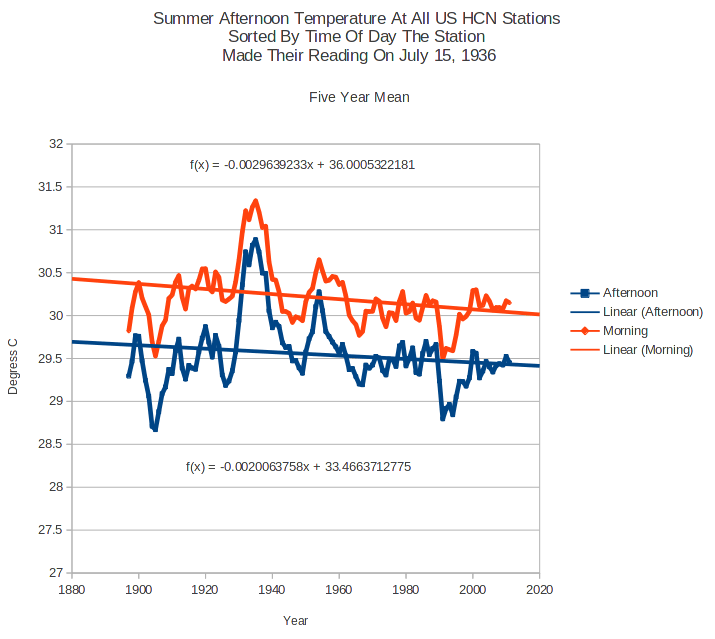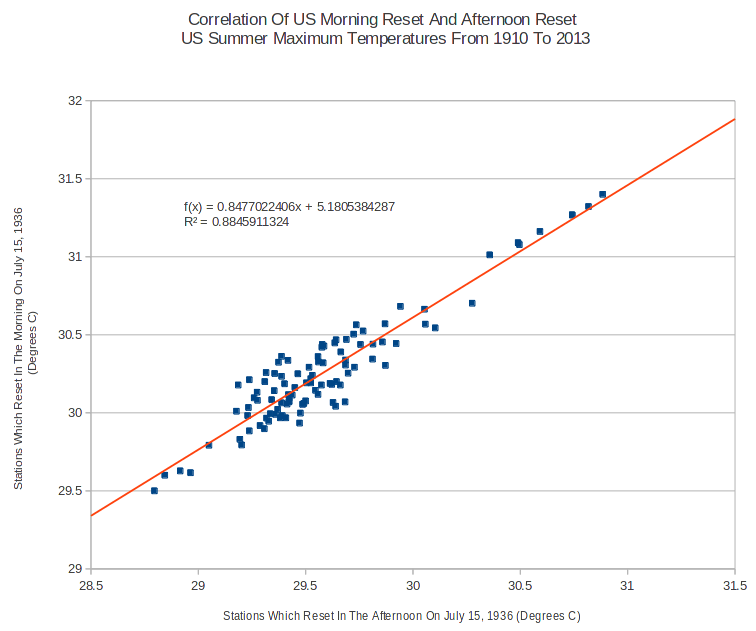Someone was suggesting earlier that the graph below showing NCDC TOBS adjustments are unwanted, might just be a coincidence.
So I did a correlation between the two data sets, and found it is excellent.
The important thing to remember is these two data sets consist of a completely different set of US stations, with different time of day observations as of July 1936, yet they show excellent correlation.
This shows us that both the NCDC TOBS adjustments and the infilling adjustments are completely unnecessary, and destructive to the US temperature record. They cool the past and create a fake warming trend.




Nicely done!
This should be obvious to most casual observer!
Reblogged this on Edonurwayup's Blog and commented:
Another temp tampering fraud.
A hilarious exchange!
NASA GISS runs ‘hot’ and ‘cold’ as an outlier again (From Anthony’s web site)
Mosher says:
“Absolutely (and highly regrettably) true. I have adjusted data, and dropped stations from the record for moves, for TOBS, and adjusted for MMTS conversion. Both times, the trend was warmer than when I started, too, I might add. But the idea is to get it right.”
Problem is you cannot trust the metadata without a cross check.
For example. The record may show NO move, but the actual agency that controlled the site ( not noaa) will show a move.
That is why you have to cross check for the following
1. undocumented changes in TOB
2. in documented changes in instrument
3. un documented stations moves
You can do this with break point analysis. its simple. you WITHHOLD the metadata.
you then run your breakpoint code. the breakpoint code will predict
changes at time a, b, c, d . you then look at your metadata and see how many you corrrectly
identify.
Trusting metadata is probably the worse mistake one could make. I hope you didnt trust it.
in other words just because a record fails to identify a change does not mean there wasnt a change
you need cross checks. from other metadata sources and from the time series itself
REPLY: “The record may show NO move, but the actual agency that controlled the site ( not noaa) will show a move.”
Mosher, this is ridiculous. All the COOP stations are managed by NOAA, local NWS WSFO’s there is no other “agency” with station metadata. Don’t make stuff up. – Anthony
evanmjones says:
July 17, 2014 at 8:19 pm
@Steve Mosher
The NOAA TOBS data comes right off the B-91 or B-44 (etc.) forms. I don’t see how you can get a more reliable record than that. The originals are available as PDF.
We prefer to find the cleanest set of stations we can possibly find and adjust as little as possible. Break points can occur naturally. Unless you have a specific reason for that break point there is insufficient cause to adjust. And if there is, we do not adjust — we drop.
I calculated a binomial trendline for NOAA’s temperature adjustments done to the 1900s. R squared was .9, a superb correlation. y=0.00011×2 – .00919x + .09773
Extended to the present, 2013 was “adjusted” up .5 degrees, over 80% of the reported per-century warming trend.